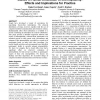Free Online Productivity Tools
i2Speak
i2Symbol
i2OCR
iTex2Img
iWeb2Print
iWeb2Shot
i2Type
iPdf2Split
iPdf2Merge
i2Bopomofo
i2Arabic
i2Style
i2Image
i2PDF
iLatex2Rtf
Sci2ools
CHI
2007
ACM
2007
ACM
Biases in human estimation of interruptibility: effects and implications for practice
People have developed a variety of conventions for negotiating face-to-face interruptions. The physical distribution of teams, however, together with the use of computer-mediated communication and awareness systems, fundamentally alters what information is available to a person considering an interruption of a remote collaborator. This paper presents a detailed comparison between selfreports of interruptibility, collected from participants over extended periods in their actual work environment, and estimates of this interruptibility, provided by a second set of participants based on audio and video recordings. Our results identify activities and environmental cues that affect participants' ability to correctly estimate interruptibility. We show, for example, that a closed office door had a significant effect on observers' estimation of interruptibility, but did not have an effect on participants' reports of their own interruptibility. We discuss our findings and their i...
ACM Classification Keywords | Awareness Systems | CHI 2007 | Computer-mediated Communication | Human Computer Interaction |
| Added | 30 Nov 2009 |
| Updated | 30 Nov 2009 |
| Type | Conference |
| Year | 2007 |
| Where | CHI |
| Authors | Daniel Avrahami, James Fogarty, Scott E. Hudson |
Comments (0)

